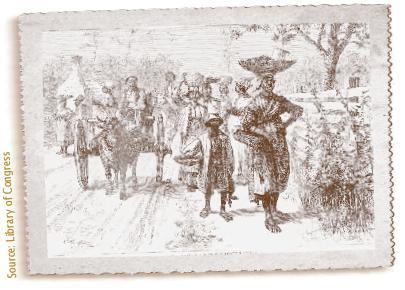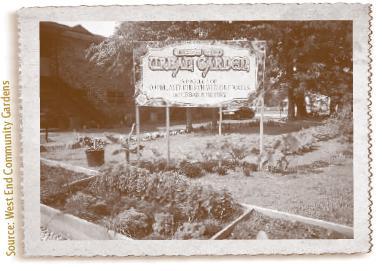America I AM Pass It Down Cookbook (22 page)

Add maple syrup and cayenne pepper, if using, turn heat down to medium, and toss the greens around again. Cover and cook about 1 more hour (tossing occasionally).
The Kitchen Garden
PLOTTING THE PAST AND FUTURE
BY MICHAEL TWITTY
 From earliest colonial times, African Americans tended the plantation kitchen gardens and small gardens in their homesteads, and then took those goods to market.
From earliest colonial times, African Americans tended the plantation kitchen gardens and small gardens in their homesteads, and then took those goods to market.
Michael Twitty is an African American foodways historian who worked with D. Landreth Seed Company to develop the African American heritage collection. Read more about him in the essay “Finding My Way Home,” on
page 15
.
I
n West and Central Africa,
members of every caste and class had small, productive gardens within the home compound. These were used largely to produce fruits, vegetables, and condiments that enhanced a diet based on pounded starches and soups and stews. Even members of traditional societies that were enslaved regarded their kitchen gardens and subsistence plots as a right rather than a privilege.
Despite being brought to the Americas as slaves, Africans kept their tradition that said that everybody, including those enslaved or indentured, had a right to the cultivation of the land for the sake of their household. This tradition helped shape the contours of the African American experience in slavery. From Caribbean plots on mountainsides to acres of land in the woods to plots near cabins—gardens thrived in the enslaved communities.
Having a garden was a major element of cultural and social empowerment. These plots allowed enslaved people to control part of their food supply, grow healthy food, and give them some sense of ownership. Gardens provided many with the means to barter their goods and produce and sell them for money. At Monticello there are extensive records showing that Thomas Jefferson’s workforce sold him a wide variety of produce from their own personal plots.
Access to markets in towns and cities enabled enslaved blacks to communicate with the outside world, providing contacts and the potential for freedom. Every member of the family put time into these plots—some by daylight, some by moonlight and torch.
Many of these gardens were based on companion planting—growing plants that complement each other’s growth. And intercropping—planting more than one crop in the same mound or row rather than in individual sections—was the rule. This reduced insects, preserved water, conserved space, and helped retain and enhance soil nutrients. Our ancestors were colonial America’s premier organic farmers. Any ashes, bones, and other “waste” would have been used to keep the garden fertile.
There is no “typical” produce list for enslaved people’s gardens. These plots certainly helped preserve African food traditions even as new foods from the Americas and Europe were incorporated into the diet of the enslaved community. Many of these foods had already made inroads in West and Central Africa, and were already familiar to enslaved Africans and their descendants. By the 18th century, corn, pumpkins, squashes, gourds, sweet potatoes, white potatoes, peanuts, black-eyed peas, beans, watermelons, muskmelons, and sorghum seeds would be left for future generations to find in archaeological digs.
From the same period onward, enslaved African Americans are described growing peppers, okra, onions, cabbage, collards, turnips and turnip greens, rice, sesame, tomatoes, herbs, and other crops. These garden plots would prevail throughout Southern rural history. As African Americans migrated to Southern cities and moved north and west, however, it became harder to maintain the garden-ways of the South, but in many urban community gardens this ancient tradition is preserved today.
For tips on pickling, canning, and preserving the bounty of your own garden, see Tips for Boiling Water Bath Canning (
page 228
).

“I was born in Newberry County, near Chappelle Depot. My master in slavery time was John Boazman . . . The folks back home had fine farms, good gardens, and took pride in raising all kinds of things in the garden. They allus planted Irish potatoes the second time in one season.”
— Ex-slave Caroline Farrow,
ewberry, South Carolina, 1937
Courtesy:
Born in Slavery: Slave Narratives from the Federal Writers’ Project, 1936–1938,
Library of Congress American Memory Collection

Community Gardens
BY CHAZ FOSTER - KYSER

Chaz Foster-Kyser is a New York–based writer, editor, and vegetarian who loves shopping at local farmer’s markets and is a big supporter of urban farming. She is the author of
Embracing the Real World: The Black Woman’s Guide to Life After College.
W
est End Community Gardens,
affectionately known as “we garden,” is an example of African Americans’ ongoing commitment to feed those within the community using their own land, labor, and knowledge of crop cultivation. Located in Birmingham, Alabama, the garden was created in 2008 through the joint effort of Urban Ministry, a non-profit that provides philanthropic services to West End residents, and Community Church Without Walls, a church that meets in the homes of its members.
Like many urban areas, West End is largely devoid of the type of services and businesses that make a community viable, such as grocery stores with fresh and inexpensive food. Childhood obesity, high blood pressure, and diabetes due in part to this inequality are among the many health issues people within West End contend with. Yet West End Gardens is not only helping to alleviate these issues, it is bringing community members together in the process. The “green” gathering rests on a half-acre city lot and has three common garden areas used to raise vegetables that can be sold at markets and to local restaurants. It also houses 16 community plots that residents can utilize through volunteering or by leasing for a nominal fee. Gardeners are furnished with soil, natural fertilizers, seed, seedlings, and basic organic gardening instruction. There are even six “baby boxes” for young children to use as they learn how to grow their own plants.
The West End Gardens boasts foods ranging from arugula to yams and a variety of field peas, peppers, and tomatoes. It is especially known for its 12-foot-tall okra as well as its collard greens, highlighted during the garden’s annual Collard Green Cook-Off.
The prized garden is as beautiful as it is bountiful, as herbs and flowers grow alongside fruits and vegetables. And just like community gardeners of yesterday, members consistently practice companion planting and crop rotation. They also make their own compost, which is generously incorporated into the garden beds.
The garden has been so successful that members have formed a Community Gardening Resource Team to assist others with starting gardens—demonstrating the “each-one-teach-one” belief needed to keep community gardens a part of African Americans’ history and future.
Community gardens enrich the lives of people living in other urban areas across the United States as well, often receiving support from city governments, universities, and non-profit organizations. In Detroit, many trash-strewn vacant lots have been transformed into community gardens through the Garden Resource Program, an initiative sponsored by The Greening of Detroit, the Detroit Agriculture Network, EarthWorks Urban Farm/Capuchin Soup Kitchen, and Michigan State University. Together, they provide residents with the supplies and resources needed to grow fruits and vegetables. When the program was first implemented in 2004, Detroit had 80 registered urban gardens. Today, more than 700 are spread throughout the city.
To learn more about community gardens, visit the American Community Gardening Association’s website,
www.communitygarden.org
.

“I have found that the way to a community’s heart is truly through its stomach. Feed a community well and they respond in kind. The simple act of planting a garden has transformed my life.”
— Ama Shambulia,
West End Community Gardens’ Program Director

